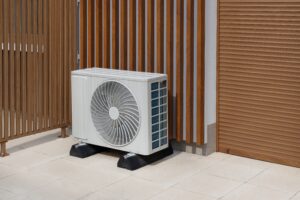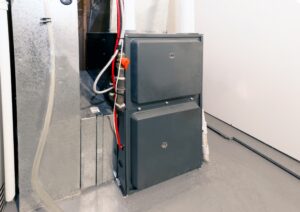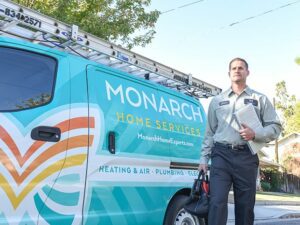If you live in the Central California area, including the San Joaquin Valley, you need a heating system that keeps your home comfortable during the cold winter months. Many homeowners aren’t aware of the differences between heat pumps vs. traditional heating systems, but you should know what makes them unique. The experts at Monarch Home Services have insightful information about how these heating systems work, which options are best for energy efficiency, the associated costs, and more.

How Do Heat Pumps and Traditional Heating Systems Work?
Knowing about the pros and cons of heat pumps and traditional heating systems and how they work helps you to make an informed decision when you need repairs, maintenance, or a new system upgrade.
Heat Pumps
Heat pumps use electricity to transfer heat from one place to another, extracting heat from the surrounding air or ground and moving it inside your home. Heat pumps perform two tasks in one: they heat your home in the winter and cool it in the summer. Rather than generating cool or warm air, heat pumps move the air around, which makes them an energy-efficient choice.
Here are some key points about how a heat pump operates.
- Refrigerant is the core component of a heat pump, absorbing heat whenever it evaporates at a low pressure.
- The refrigerant releases heat when it’s condensed at a high pressure.
- Heat pumps use a compressor to increase the pressure of the refrigerant, which raises its temperature.
- A heat exchanger transfers heat from the outdoor air to the refrigerant while in heating mode and from the indoor air to the refrigerant while in cooling mode.
- The refrigerant in the outdoor coil absorbs heat from the outside air, causing it to evaporate into a low-pressure gas. A compressor raises the gas pressure to increase its temperature. Next, the hot refrigerant flows through an indoor coil and transfers the heated air into your home.
Traditional Heating Systems
Furnaces and boilers are the most common types of traditional heating systems, but each system works differently.
- Furnaces: These pull cool air from your home and heat it through the combustion of fuel like propane or natural gas. The combusted fuel transfers heat to a heat exchanger and pushes the warmed air into your home through ductwork via a blower fan. Your thermostat controls the furnace, signaling the system to turn on or off based on your set temperature.
- Boilers: They heat water inside a sealed chamber using a fuel source like oil, gas, or electricity. The heated water circulates through a system of pipes that delivers the heated water by steam throughout your home.

Energy Efficiency: Heat Pumps vs. Furnaces
Heat pumps provide eco-friendly heating solutions for your home. Before you decide on a new furnace or heat pump installation, learn the differences between furnace and heat pump efficiency to help you make a well-informed decision.
Heat Pumps
- Heat pumps are energy efficient because they circulate warm air rather than generate it. However, they do require electricity to operate.
- A heat pump is a good choice for mild climates where the unit transfers heat from the outside to the inside.
- Heat pumps use electricity, so they don’t burn fossil fuels.
- A heat pump cools and heats your home in one system, meaning that energy savings with heat pumps make them a better choice overall.
Furnaces
- Furnaces require a form of fuel, whether it’s electricity, natural gas, or propane, to generate heat.
- Furnaces are more efficient in colder climates because they generate heat more effectively in areas where the temperatures dip near or below freezing.
- Oil or gas furnaces emit greenhouse gases whenever they’re operational.
- You’ll need a separate air conditioning system to cool your home if you have a furnace.
Upfront and Long-Term Costs Comparison
In addition to operation and energy efficiency, it’s important to compare the upfront and long-term heat pumps vs. traditional heating system costs. Gas furnaces tend to cost less upfront but will cost more if you need to install a new gas line and ventilation system. In terms of operational costs, electric heat pumps may cost more since natural gas is generally cheaper than electricity.
When it comes to maintenance, gas furnaces require more repairs than heat pumps. Heat pumps also run more efficiently than furnaces in moderate climates like Central California. They tend to have a lower lifetime operating cost overall.
As for the lifespan of heat pumps vs furnaces, a furnace lasts longer, with a typical service life of between 15 and 20 years. Heat pumps last between 10 and 15 years because they operate year-round for both heating and cooling, leading to more wear and tear. However, regular preventative maintenance, including cleanings and tune-ups, can prolong the service life of both furnaces and heat pumps.
Environmental Impact: Which Heating System Is Greener?
Heat pumps are considered greener than furnaces in terms of environmental impact. These systems transfer heat rather than burning fossil fuels, resulting in fewer greenhouse gas emissions. Most furnaces require oil or natural gas to operate, so they contribute to carbon emissions via combustion.

Contact Monarch Home Services Today!
Monarch Home Services is available to help with all your home heating needs in Central California. Whether you need assistance with your heat pump or a traditional heating system, we offer a range of services, including professional repairs, maintenance, and new installations. If you’d like to learn more or want to schedule a consultation, contact us today!


